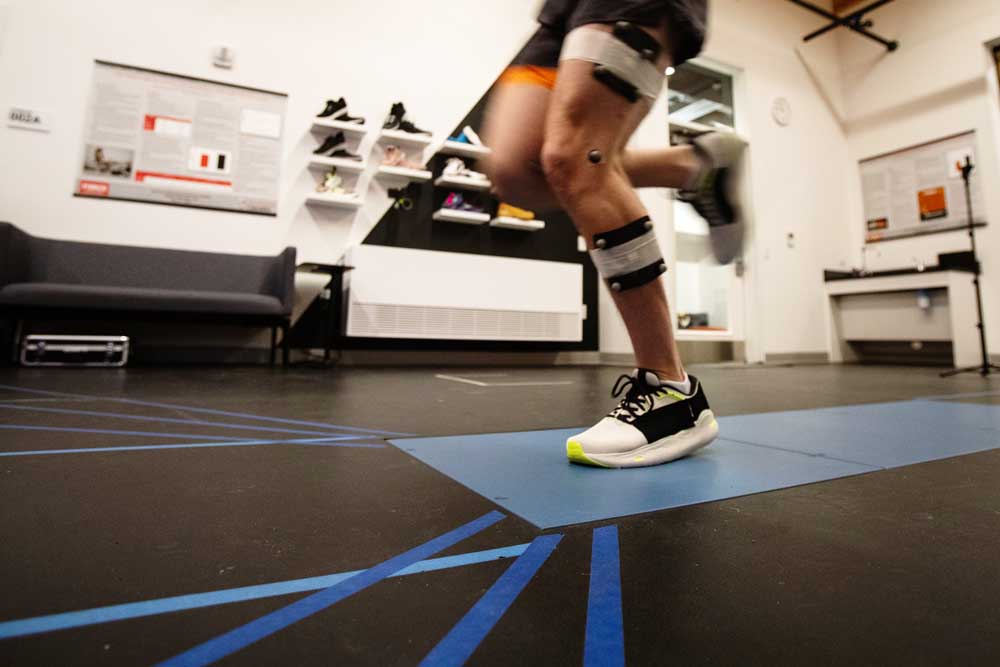OSU-Cascades lab uses biomechanics research to prevent athletic injuries
Published 5:45 am Sunday, March 10, 2024

- Oregon State University-Cascades student Tanner Farley demonstrates some of the footwear research done in the FORCE lab by running across plates that measure impact as motion capture cameras record information from markers affixed to his legs on Thursday in Ed Ray Hall on the OSU-Cascades campus in Bend.
Tanner Farley, a lean, shirtless runner, dashed across the lab room floor over and over, his feet landing ever so briefly on a flat, rectangular sensor stretched out like a long blue tile.
With every pass, the sensor — called a force plate — measured the impact of his stride. At the same time, cameras captured the action and a computer screen nearby displayed Farley as a skeleton in motion.
This data collection is part of Oregon State University-Cascades’ biomechanics research efforts in the Functional Orthopedic Research Center of Excellence, also known as FORCE.
The lab, founded in 2013, is designed to study human movement in order to better understand how people injure themselves and how to prevent injuries. Researchers want to use the results to help clinicians in the community treat patients and help athletes to improve their well-being.
JJ Hannigan, assistant professor in the Doctor of Physical Therapy program, and David Phillips, assistant professor of kinesiology, watched as Tanner ran over the force plate.
“The overall goal is to study how people move to better understand risks for injury and then also learn how to better prevent certain injuries,” said Hannigan.
Hannigan focuses on running-related injuries, while Phillips focuses on how muscles turn on and off during different movements. He’s especially interested in how people with a lower risk of injury compare to those with a higher risk.
“For upper extremity research, I also look at how the muscle contracts around the shoulder when they activate and when they turn off, again stabilizing what’s a fairly unstable joint,” said Phillips.
The lab has several systems that help measure data. The first is a motion capture system that uses cameras and small markers attached to study participants to record the movements they make.
Force plates measure impact, and are made of steel mounted on top of sensors. When someone lands on one, the plate measures the impact in all directions.
The lab recently published a study focusing on running-related injuries for adolescents and how different shoes, especially those that have different levels of cushioning, can affect how youth run.
“Until the last few years, we really didn’t know how that extra cushioning was affecting your biomechanics,” said Hannigan.
Some data indicated runners who were barefoot, or wearing less well-cushioned shoes, had an increased risk of stress fractures. The risk of injury also depends on the shoe, and no one shoe is right for everyone, he said.
Who works in the lab?
The lab is part of the Doctor of Physical Therapy program and the kinesiology program, and has students from both working there as well as other departments. Undergraduate and graduate students work in the lab. Occasionally there is funding for research assistants, said Phillips.
“(Students can approach me) and I find a way for that student to be involved, particularly if that student is interested in things like DPT programs post-graduation or graduate programs in kinesiology,” said Phillips. “I want to bring them into the lab so they can get exposure relatively quickly to see if that’s a career path they want.”
Students also have the opportunity to apply for research fellowships to gain funding for a project.
In the lab, students gain technical skills on lab software, as well as how to organize and how to interact with subjects.
“Specifically for our physical therapy students, we think it’s really important for them to get exposed to the research process, ‘cause that’s going to make them better clinicians,” said Hannigan.
Importance of the lab
Hannigan and Phillips want the lab’s research to help people.
“(In Bend), because we have an active population, we have a high proportion of orthopedic injury, and we, through our research, want to get the clinicians some better tools in terms of educating and treating their patients for those injuries,” said Hannigan.
The lab has an industry partner that works on footwear testing and brings in community members to help test shoes. In the future, Hannigan said he’d eventually like to help the community by providing running evaluations.
Hannigan said he’s also starting to think about the research that can be conducted outside the lab, including running-related research on trails.
“Sometimes there’s questions that are better answered out in the field, so (I’m) thinking about those types of research questions as well,” said Hannigan.
Financial aid applications delayed for Central Oregon college students






